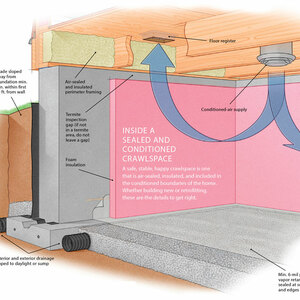I am building a custom shower ~4′ x 5′ and I am including a steam unit. Because the enclosure will need to have tight seals, I need to incorporate a method of venting the space when used as a convential shower. I’ve considered glass louvers in the transom, but that got expensive. Now I am considering using an operable skylight. The manufacuturor (Velox) believe I can paint their wood clad (interior) window to protect it from the steam.
Any thoughts?


















Replies
Not sure if this would work for you, but Solatube (sp?) tubular skylights can be optioned to include an integral exhaust fan. And the surround for the skylight opening/exhaust fan is plastic I believe.
Google solatube
I do not think you would want anything made of wood at the top of a steam room. How about venting with a conventional exhaust fan?
csnow- Good idea. The fan should be on a timer or even better wired to a dehumidistat with a lockout for periods of steamer operation.
murrayjw- Steam units can be very problematic for building durability. removal of moisture is essential. If the unit is on an exterior wall, the vapor drive can easily overload a wall systems ability to handle it. Don't put wood in there. Instruct the owner to leave the door open when finished if the fan will not be used. Good luck
My advice ( for whatever it's worth):
1) Cover all of the ceiling and skylight shaft framing with 6 mil poly, as seamlessly as possible. Tape the very few seams you must have with Tyvek tape.
2) Insulate the ceiling and skylight shaft to try and prevent condensation.
3) Install an exhaust fan as high as possible in the skylight shaft and use it.
4) Operable Velux skylight, electric remote control models are nice but not cheap; Grace ice and water shield is great for sealing instead of felt; be sure to buy the factory flashing kit for your roofing type.
5) Greenboard everywhere; corrosion resistant screws; Strait-Flex flexible composite corner bead for the wierd angles created by the skylight shaft, http://www.straitflex.com , no rust stains - ever.
6) Consider the use of marine grade enamels on the wood on the Velux window. Hull paint would probably be your best bet, topside paint second choice. I realize that the wood is already treated with some sort of preservative by Velux. The marine paint certainly won't hurt and will probably help.
Jim
Never underestimate the value of a sharp pencil or good light.
.
Great suggestions. One small detail, how would you finish the light shaft?
I have a sealed skylight right over a tub-shower unit and an exhaust fan in the room, the paint in the shaft starts peeling in a few short years. It will help if the exhaust is relocated to the top of the shaft but all things considered I would rather scrape and paint every few years.
I don't know how or what to finish the light shaft with to prevent peeling paint without vigorous ventilation.
All of my clients for whom I have installed skylights in bathrooms ( popular option) were informed they needed a fan at the top of the shaft; installed with the skylight. No complaints as to peeling paint - Benj Moore latex in the shaft. Many are repeat customers and I am sure I would hear about it or see it.
I usually install operable skylights, but that only helps a few months a year, as during heating and cooling seasons I don't think the skylights are open too much! Ther are only about 45 non-heating, non-cooling days per year in Delaware.
Jim
Never underestimate the value of a sharp pencil or good light.
If you use a wood skylight, it should be coated only with microporous finishes. Any type of impermeable paint such as epoxies or boat coatings will blister. The europeans have this figured out better than we do. Coatings such as K-cron on the Kolbe and Kolbe windows are dependent on a perfect seal. They will eventually crack at a joint and the water that intrudes will get behind the finish. When the sun hits the surface, the vapor pressure in the heated wood will blow the finish off the surface. Paints in wet or very damp areas must be breathable and must have an opportunity to dry intermittently. If coatings are left off one side and drying is possible to that side, a certain amount of water intrusion can be tolerated but not much.
I don't claim to be a painter. The marine grade enamel which I referred to would be something along the line of Valspar polyurethane enamel. It is not an epoxy or a polyester gel coat.
Recommendation based purely on observation of boat finishes which are wet (not damp) daily. Even when not underway the boat is exposed to dew, rain and sun, all while floating in a near 100% humidity atmosphere. These polys generally fail first at seams in the boat hull. I believe that the failure is caused primarily by the planks in the hull working (flexing / moving) while the boat is underway. First signs of cracking always appear near the bow. Typically when one is sanding the hull for repainting, the paint on the flat center of the planks is doing great while the edges / seams are showing the wear.
Boat hulls, especially in the bow area, are subjected to stresses which would make the skylight framing and trim simply explode.
Jim
Never underestimate the value of a sharp pencil or good light.
if you put a skylight in that steam room , it's going to rain a lot..
as mentioned.. a high exhaust fan is the correct solution.. and a great vapor barrier